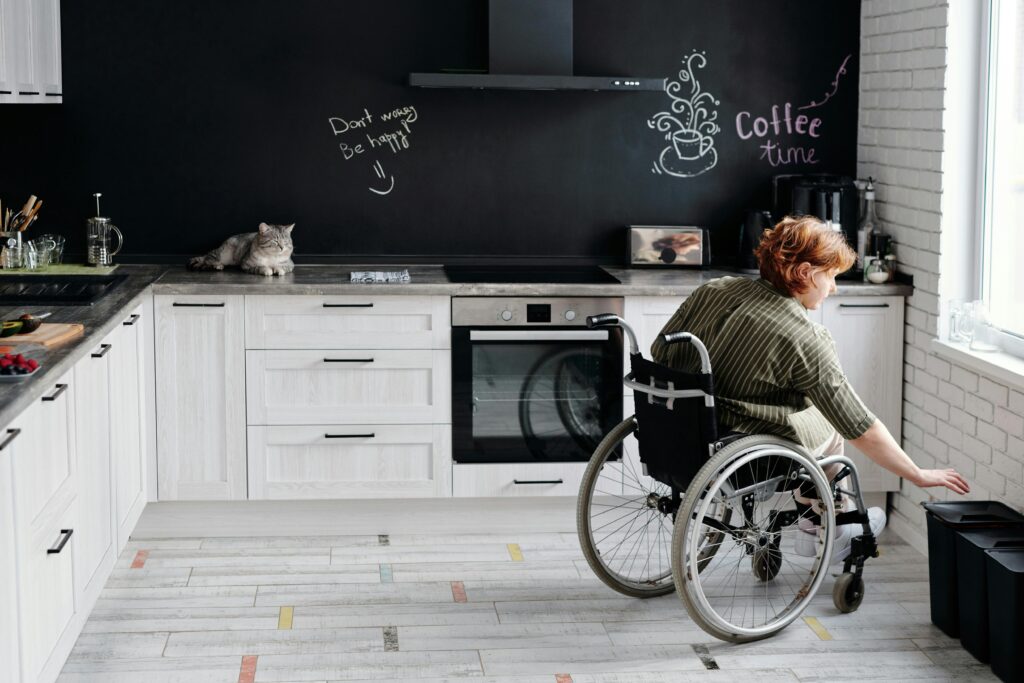

Create a safer, more comfortable home as you age. Use our aging in place checklist to plan smart upgrades and stay independent for years to come.
Creating a Home That Grows With You: An Aging in Place Checklist
Most people want to stay in their own homes as they age, and for good reason. Familiar surroundings, daily routines, and a sense of independence all contribute to quality of life. But as your needs change, so should your home. The good news is that preparing for the future doesn’t mean starting from scratch. It means making smart updates now that allow you to live safely and comfortably for years to come.
Why Aging in Place Matters
The choice to stay in your own home as you age is a profoundly personal and practical decision. Aging in place helps preserve your independence while avoiding the emotional and financial toll of moving into assisted living.
It’s also often the more affordable option. Proactive upgrades like grab bars, better lighting, or wider doorways may seem costly at first, but can prevent urgent, expensive renovations down the road and reduce the risk of injury.
As baby boomers retire, aging in place will become far more common. By 2030, over 20% of the U.S. population will be 65 or older, sparking greater interest in home modifications and universal design. Preparing now helps ensure your home remains a safe, comfortable, and empowering space for years to come.
The Complete Aging in Place Checklist
You don’t need to remodel your whole house to make it safer and easier to live in during retirement. Small changes in key areas can make a big difference. This checklist breaks it down room by room to help you plan ahead.
1. General/Whole-Home Upgrades
Start with the basics that make moving around easier and safer, no matter where you are in the house. Widen doorways and hallways so there’s enough space for a walker or wheelchair. Anchor your area rugs so they don’t slide, and place stair treads on your steps to prevent slips and falls.
Simple smart home tech can help, too. Voice-controlled lights, thermostats, and locks reduce the need to bend or reach. Swap standard switches for rocker switches, and lower outlets so they’re easier to access. It’s also worth installing a fall detection system or medical alert—just in case.
2. Entryways and Exterior Modifications
Getting in and out of your home should be safe and straightforward, especially in bad weather or when using mobility aids. If your entry has steps, consider replacing them with a sloped concrete or wood ramp that has sturdy railings on both sides. For added grip, use non-slip tread strips on the ramp surface.
Replace doorknobs with lever-style handles that are easier to use if you have arthritis or limited hand strength. Outside, install bright LED motion-sensor lights near all entry doors and along paths or driveways. This not only improves visibility at night but can also deter intruders. If your front door doesn’t already have one, add a covered porch or awning to keep rain, ice, or snow from making the entry slippery.
3. Living Room and Common Areas
Clear, wide walkways are key. The wider they are, the more space you’ll have to maneuver with a walker or wheelchair. Avoid using coffee tables or ottomans that block paths, and secure electrical cords along walls to eliminate tripping hazards.
Install dimmer switches for overhead lights and lamps so you can easily adjust brightness throughout the day. If you have low vision or depth perception issues, consider using contrasting colors, like dark floors with light-colored baseboards or furniture, so it’s easier to tell where things begin and end.
Keep everyday items in reach. That means avoiding high bookshelves or deep cabinets. Use lower, open shelving or baskets to make storage accessible without climbing or bending.
4. Kitchen Considerations
The kitchen can be one of the trickiest spaces to navigate, so start with storage. Install pull-out shelves in lower cabinets so you can access items in the back without kneeling or bending. Lazy Susans are great for corner cabinets, and drawer-style dishwashers or side-opening wall ovens make everyday tasks easier.
Choose lever-style or touch-activated faucets, which require less grip strength. Replace small cabinet knobs with large, easy-to-grasp handles. Place slip-resistant mats with beveled edges in front of the sink and stove to prevent slipping while standing for long periods. Keep counters and floors clear of clutter so you can move freely, and make sure lighting is bright and even across all prep areas.
5. Bathroom Modifications
Falls are common in bathrooms. Over 80% of household falls happen in the bathroom. Small changes can lower the risk. Swap out your tub for a low-threshold walk-in shower with a built-in or fold-down seat. Place vertical and horizontal grab bars inside the shower and beside the toilet, and make sure they’re properly anchored into wall studs — not just glued or suctioned on.
Install a handheld shower head with a long hose that can be used while seated. Add an anti-scald device to your faucets or set your water heater to a safe temperature (around 120°F) to avoid burns. A raised toilet seat or a comfort-height toilet can also reduce the strain on your knees and hips when sitting or standing.
6. Bedroom Adjustments
If climbing stairs is becoming more difficult, plan to move your bedroom to the first floor if possible. Choose a bed height that allows your knees to be at a 90-degree angle when sitting, or use risers to adjust as needed. Avoid thick bed skirts or rugs that can get caught underfoot. Also, leave a wide walking path on both sides of the bed to the door. Plug in nightlights with motion sensors along the floor to guide you safely if you get up during the night.
In closets, lower rods and add pull-down systems or tiered shelving so you can reach clothes without stretching. Consider adding lighting inside the closet as well, especially if it’s dim or deep.
How To Prioritize Your Renovations
When planning to age in place, start with the changes that matter most for safety. Bathroom grab bars, non-slip flooring, and better lighting are usually the first upgrades worth making. These minor fixes can prevent falls and injuries, making a big difference right away.
From there, think about what you can realistically take on yourself versus what requires a pro. Swapping out light switches or adding motion-sensor lights might be DIY-friendly. On the other hand, widening doorways or building a ramp is best left to a contractor.
If cost is a concern, break your plans into phases. Focus first on high-risk areas like bathrooms and entryways. Then, space out other improvements — like smart home tech or kitchen upgrades — based on your timeline, mobility, and budget.
How To Anticipate Evolving Needs
It’s easy to focus on your needs today, but the smartest renovations also consider how things might change down the line. Maybe your eyesight is fine now, but contrast-rich design can help if that changes. Mobility might not be an issue yet, but planning for future use of walkers or wheelchairs can save time and money later.
If you share your home with family, universal design is a smart approach. It keeps the space usable and comfortable for everyone — young kids, older adults, and people with different abilities.
You don’t have to do all the planning alone. Certified Aging-in-Place Specialists (CAPS) are trained to design home modifications that fit your current and future needs. Working with one can help you avoid common mistakes and make sure your home stays functional as you age.
Make Your Home Work for Every Stage of Life
Planning isn’t just about convenience. It’s about protecting your independence. Whether you’re making your first change or your tenth, each step helps build a home that’s safer, more comfortable, and ready for whatever comes next.
You don’t need to do everything at once. Maybe you start with a grab bar in the shower or get a quote for a stair lift. Even looking into financing or mortgage protection insurance can be a helpful first step if bigger upgrades are on your list.
Want more practical advice like this? Sign up for the free My Guide to Retirement newsletter and get tips on planning for the future, delivered right to your inbox.
FAQs About Aging In Place
Start with the changes that directly affect safety—like installing grab bars in the bathroom, securing loose rugs, and improving lighting in high-traffic areas. These upgrades are low-cost, easy to install, and can help prevent falls, which are one of the leading causes of injury for older adults.
Costs vary depending on the scope of the work. Basic updates like non-slip flooring or grab bars might cost a few hundred dollars. More involved renovations—like walk-in showers, ramps, or wider doorways—can run several thousand. Creating a phased plan based on your needs and budget can help spread costs over time.
Yes. Some local governments, nonprofits, and programs like Medicaid Home and Community-Based Services (HCBS) offer grants or low-interest loans for home modifications. Veterans may qualify for aid through the VA. In some cases, mortgage refinancing or home equity loans can also help cover larger projects.
Universal design means creating spaces that work for people of all ages and abilities—not just older adults. Features like no-step entries, lever handles, wide doorways, and good lighting help everyone—from toddlers to grandparents—live more comfortably and safely under one roof.
That depends on the task. Swapping out cabinet hardware or installing motion-sensor lights can be DIY-friendly if you’re comfortable with tools. But larger projects like ramps, bathroom remodels, or electrical work, a licensed contractor should handle—ideally someone certified in aging-in-place design (CAPS).
A CAPS (Certified Aging-in-Place Specialist) contractor has specific training in designing and building home modifications for older adults and people with mobility limitations. They understand how to make homes safer and more functional without sacrificing style or comfort.
Yes—especially if the changes improve safety and comfort now. Many aging-in-place features add resale value and appeal to buyers of all ages. Features like step-free entries, bright lighting, or universal kitchens are often seen as long-term lifestyle upgrades, not just accommodations.
Start Planning Today for a Secure and Healthy Retirement
Use the free tools and resources at My Guide To Retirement to plan a comfortable and fulfilling retirement, according to your specific financial and health goals.

